Ch. 9 Internal Regulation
1/49
There's no tags or description
Looks like no tags are added yet.
Name | Mastery | Learn | Test | Matching | Spaced |
|---|
No study sessions yet.
50 Terms
Health Consequences of Obesity
Hypertension
Sleep Apnea
Arthritis
Peripheral Artery Disease
High Cholesterol & Triglycerides
Coronary Heart Disease (also caused by diabeties)
Diabeties
Diabetic Complications
Social Disability
Obesity is ranked as…
One of the top 5 health problems in developed nations according to the World Health Organization
Body Mass Index (BMI)
Is used as a measure of body fat
BMI = body weight/ (height²)
Obese
BMI >/= 30 kg/m²
More than 1 in 3 adults, aged >/= 20yrs (>60 million)
Claude Bernard (1813-1878)
French psychologist who is considered the “father” of modern experimental psychology
Studied the physiology of digestion, particularly the role of the pancreas
Contributed to the understanding of glucose regulation in the liver
Claude Bernards Finding on Weight Regulation
Weight is regulated homeostatically
Proposed the concepts of:
Homeostasis = controlled stability of the ‘internal milieu’ (i.e., internal environment) of cells & tissues
Feedback control loops = explained how certain systems work as homeostatic mechanisms
Homeostasis
Of biological processes Kees certain target body variables at a specific SET POINT or within a fixed range
Ex: body levels of water, oxygen, pH, glucose, sodium chloride, protein, fat.
Homeostasis
Bio-mechanisms that reduce discrepancies from the set point are known as NEGATIVE FEEDBACK PROCESSES
For many years it was hypothesized that obesity was a consequence of a failure of body weight homeostasis
Hunger
Is the stimulus that drives our need to ear
When our bodies need fuel, signals are sent from the empty stomach & intestine that trigger feelings of hunger
Signals of Hunger
processed by the brain but we can override them:
delay hunger response actions e.g., people who fast or starve typically have lower hunger
Ear more than we need by ignoring satiety receptions that signal fullness e.g., “supersize me”
Process of digesting food
Digestive System
Function of the digestive system is to break down food into smaller molecules that the cells can use
Digestion
Begins in the mouth where enzymes in the saliva break down carbohydrates
Stomach
Hydronic acid & enzymes in the stomach digest proteins
Small Intestine
Has enzymes that digest proteins, fats, & carbohydrates & absorbs digested food into the blood stream
Large intestine
Absorbs water & minerals & lubricates the remaining materials to be excreted
Satiety
Is the feeling of fullness that stops appetite & hunger signals
The brain regulates eating through messages from the mouth, stomach, intestines, fat cells & elsewhere
Satiety signals that originate in the stomach are delayed from the start of eating, so it is easy to overeat before satiety signals are received & acted upon
The LENGTH OF TIME FOOD STAYS IN THE STOMACH & INTESTINE affects the duration of satiety & initiation of hunger signals
Distention of the duodenum can also produce feelings of satiety
The duodenum releases cholecystokinin (CCK) & GLP-1 to restrict flow through the duodenum causing the stomach to slow gastric emptying.
Both CCK & GLP-1 signal the brain satiety mechanisms
Gastric bypass surgery
is the removal or sewing off of part of the stomach
Decreased stomach size allows distention of the stomach to produce satiety sooner
People who have had their removed surgically (e.g., cancer) still report satiety. So stomach distention is to the only satiety signal
Oral Factors
The desire to taste & have other mouth sensations, such as chewing, are also factors in hunger & satiety
Persons who cannot swallow may have stomach feeding tube inserted
Food is then placed directly into the stomach but these persons report not feeling satisfied when fed;
They need to chew food to feel satisfied
So untasted meals are unsatisfying → cold diminish taste perception & food satisfaction
Foods high in protein have…
Foods high in protein have a high satiety value because they take more time to digest… thus, high protein diets are popular
Foods high in fiber have…
Foods high in fiber have a high satiety value because they stay in the stomach & intestine for longer periods of time than foods that contain concentrated sugars or highly processed foods that digest & absorb readily
People who consume quantities of whole grain products, vegetables & fruits often feel no hunger because their satiety signals remain “on”.
Foods high in fat have…
Foods high in fat although calorie dense, have a low satiety value. They fail to trigger the satiety signals.
So we often over-consume high fat foods, which tend to have the most calories
Unfortunately, many high fat foods trigger appetite
Researchers once thought that all fat was bad, but we now know that they were wrong
Fat is a major source of energy & helps the body absorb essential vitamins
is it sugar? Glucose vs fructose; food high in fructose lead to fatty liver → insulin resistance → hunger & insulin levels increase → central obesity
Stomach Wall Stretching
With eating is conveyed by the vagus nerve to the brain
The splanchnic nerves convert info about STOMACH NUTRIENT CONTENT
In between meals,
INSULIN LEVELS ARE LOW: hunger increases
GLUCOSE LEVELS ARE LOW:
Glucagon released & liver cells convert to glycogen back into glucose, which returns to the blood & slows the return of hunger
In Type 2 diabetes, INSULIN RESISTANCE (IR) occurs:
IR is the decreasedability for insulin to get glucose into body cells
More insulin needs to be secreted to get the job done
EARLY after type 2 diabeties onset…
To overcome the insulin resistance, after eating, the body releases high levels of insulin
So the person typical experiences:
Weight gain
LATE in Type 2 diabetes,
As the body is not able to produce enough insulin, not enough glucose is able to enter the cells
so the person typically experiences:
More hunger
A loss of weight [wasting]
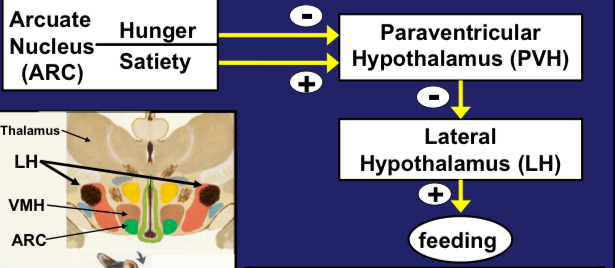
Hypothalamic Mechanisms of Eating
Damage to the LH results in loss of appetite
The PVH usually inhibits the LH to prevent feeding
Feeding occurs when the Arcuate Nucleus (ARC) inhibits the PVH, thereby releasing the LH
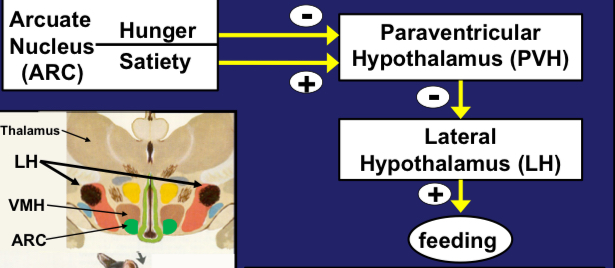
CNS Eating Mechanisms
The ARCUATE NUCLEUS (ARC) IN THE HYPOTHALAMUS has 2 sets of neurons that detect either HUNGER OR SATIETY SIGNALS
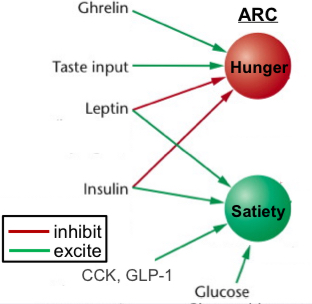
CNS Eating Mechanisms PT.2
Output from the ARC goes to the PARAVENTRICULAR NUCLEUS OF THE HYPOTHALAMUS (PVH)
When ARC hunger-sensitive neurons inhibit PVH, eating occurs
When ARC satiety-sensitive neurons excite the PVH, eating stops

Satiety signals from ARC to PVH:
EXCITATORY TRANSMITTER melancortin
Signals that trigger hunger
taste pathways
Decrease in leptin levels
GI release of ghrelin (Ghrelin rises before a meal to signal hunger & triggers stomach contractions.)
Signals that trigger satiety
GI distention triggers CCK release
Increase in leptin levels
Increase in blood glucose & insulin levels
How does one become fat or skinny?
Leptin Hypothesis
High leptin normally inhibits hunger
some obese persons have a genetic inability to produce leptin (LEPTIN SYNTHESIS DEFICIT) → more hunger
Some obese persons display less sensitivity to leptin (LEPTIN RESISTANCE)
I.e., they perceive less leptin than actually is present → more hunger
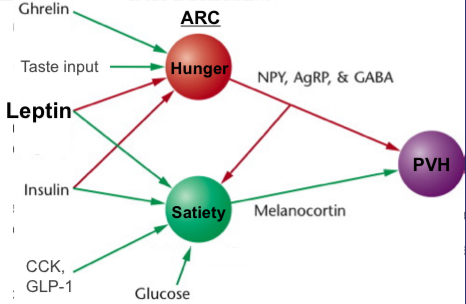
Melanocortin Hypothesis
Melanocortin normally excites the PVH to inhibit the LH & stop eating.
Some obese persons have a MUTATED MELANOCORTIN RECEPTOR GENE
So they overeat & become obese because their PVH is not able to receive the satiety signal
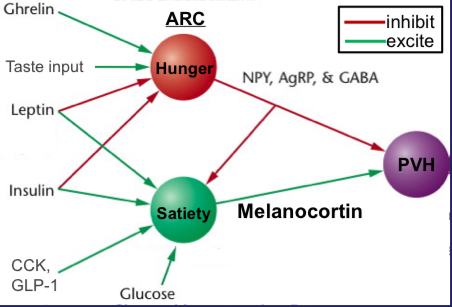
Overall Neurobiological Model of Eating
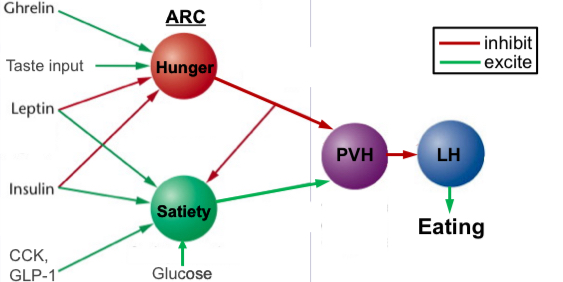
Conclusion
Body weight is the 2ND HIGHEST HERITABLE TRAIT
So their is a very strong genetic message demanding that our body weight will be similar to our parents
There are EXPLICIT NEUROBIOLOGICAL MECHANISMS that account for why we regulate body weight around a set point range
Of all the machinists that are known, WILL POWER, is NOT very likely to be one of them
When we BETTER UNDERSTAND THE INTERACTIVE NEUROBIOLOGICAL MECHANISMS UNDERLYING EATING, it will be possible to deign interventions to help overweight & obese persons maintain a healthier body weight